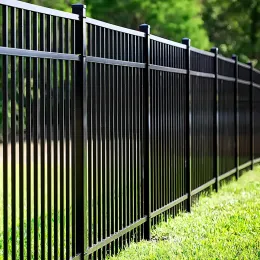What Makes a Security Fence Different?
Most people do not think much about fences at all. They certainly don’t ponder what the difference between a security fence and the fence around their backyard is, and the truth is, until they're faced with the task of choosing a fence to secure a commercial, industrial, or institutional property, they really have no idea what they are even looking for.
We DO know what the difference between security fences and residential fences is, and we are happy to share a few of the key elements you should be looking for here.

Security Fence Height
Height is one of the first things that set a security fence apart from ordinary demarcation fences. A security fence should be, at a minimum, six feet high. Most security fences are closer to 8 or even ten feet tall, and some sites, like prisons, demand fences that are fourteen feet or even higher.
Security Fencing Structure
Residential fences tend to be lighter weight since they are designed for demarcation and possibly privacy, rather than exclusion or security. Very often, they are made of wood or vinyl, and even when they are manufactured from steel, the pipe wall thicknesses and mesh wire diameters are much lower. That does make them cheaper, but will not offer much in the way of security.
Pay close attention to diameters and wall thicknesses when you are reading a security fence specification, and if something seems lightweight, ask if it is a commercial or industrial specification. Remember that the money you save upfront on a lightweight security fence might very well be made up in repairs later on.
Featured content:How High Should a Security Fence Be?
Security Above and Below
Many people focus a lot of time and energy creating a specification for the security fence itself, but they ignore what is happening above and below the fence. If your fence is made from something that can be climbed (or is located somewhere that a ladder or similar climbing device could be placed alongside it), then it is critical that you consider some sort of fence top security. This could be in the form of spikes, barbed wire, razor coils (where allowed by government), or even electronic monitoring.
The same applies to the bottom of your fence. If the bottom of your mesh can be lifted, or the fence dug under, there is a big hole in your perimeter security. Consider adding a bottom rail to fences that are installed over hard surfaces, or find out about under-fence security options to prevent digging.
Vehicular Impact
Another big factor in designing a security fence is to limit access to the site by vehicles. Ordinary chain-link and similar fences have posts spaced at up to 10’ centers, and some do not even have concrete footings. A determined person with a moderate to large vehicle could very easily breach this type of fence.
One way to improve the security of your fence is to increase the size of concrete footings and fence posts, and decrease the spacing between posts. If the posts are made of heavy-duty steel, planted in heavy-duty concrete, and it is impossible to fit a vehicle between them, it is a lot harder to gain access to the site. Another option is to choose a crash-rated fence. While this won't prevent damage to the fence, it can prevent or at least slow down unauthorized access to sensitive areas.
Nothing Is Infallible
The truth is that while all of these measures can improve the efficacy of your security fence, there are no fences, walls, or even electronic security systems that are completely impervious. You can build them to withstand the average would-be intruder, but the very determined would still be able to gain access. We do recommend, however, that if you do not know where to start designing a security fence, you contact our commercial and industrial sales team, and discuss your requirements. There is a security fence out there that meets your needs.

